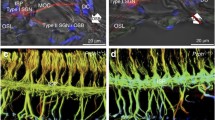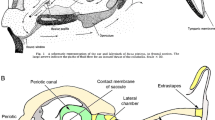Summary
The origin of efferent fibers to the inner ear was studied in Caiman crocodilus. After injection of horseradish peroxidase into the basilar papilla or into the ampullae of the horizontal and anterior semicircular canals, neurons labeled by the granular reaction product of retrogradely transported HRP were found in the medulla oblongata bilaterally. Parent cells of the efferent cochlear bundle were found in the medial reticular nucleus and in the rostroventral division of the superior olive bilaterally. Efferent vestibular neurons were found in the medial reticular nucleus bilaterally with more neurons ipsilateral to the injection site.
Zusammenfassung
Der Ursprung der efferenten labyrinthären Innervation wurde bei einem Reptil, Caiman crocodilus, untersucht. Nach Injektion von Meerrettich-Peroxydase (HRP) entweder in die Basilarpapille oder in die Ampullen des horizontalen und vorderen Bogenganges wurden die Ursprungszellen der efferenten Fasern durch retrograden axonalen Transport von HRP markiert. Die Ursprungszellen der efferenten cochleären Innervation fanden sich in der Medulla oblongata im rostroventralen Anteil der oberen Olive sowie im ventral dazu gelegenen Nucleus reticularis medius. Efferente vestibuläre Zellen ließen sich beidseits im Nucleus reticularis medius nachweisen, wobei ipsilateral zur Injektion mehr markierte Zellen nachweisbar waren.
Similar content being viewed by others
Literatur
Baird IL (1970) The anatomy of the reptilian ear. In: Gans C, Parsons T (eds) Biology of the reptilia, vol 2. Academic Press, New York, pp 193–275
Bartelmez GW (1915) Mauthner's cell and the nucleus motorius tegmenti. J Comp Neurol 25: 87–126
Boord RL (1961) The efferent cochlear bundle in the caiman and pigeon. Exp Neurol 3: 225–239
ten Donkelaar HJ, Nieuwenhuys R (1979) The brainstem. In: Gans C (ed) Biology of the reptilia, vol 10. Academic Press, New York, pp 160–200
von During M, Karduck A, Richter HG (1974) The fine structure of the inner ear in caiman crocodilus. Z Anat Entwicklungsgesch 145: 41–65
Gacek RR, Lyon M (1974) The localization of vestibular efferent neurons in the kitten with horseradish peroxidase. Acta Otolaryngol (Stockh) 77: 92–101
Goldberg JM, Fernandez C (1980) Efferent vestibular system in the squirrel monkey: anatomical location and influence on afferent activity. J Neurophysiol 43: 986–1025
Karten HJ, Hodos W (1967) A stereotaxic atlas of the brain of the pigeon (Columbia livia). John Hopkins Press, Baltimore
Klinke R, Pause M (1980) Discharge properties of primary auditory fibers in Caiman crocodilus: comparison and contrasts to the mammalian auditory nerve. Exp Brain Res 38: 137–150
Leake PA (1974) Central projections of the statoacoustic nerve in Caiman crocodilus. Brain Behav Evol 10: 170–196
Leake PA (1976) Scanning electron microscopic observations of labyrinthine sense organs and fiber degeneration studies of secondary vestibular and auditory pathways in Caiman crocodilus. Dissertation, Univ of California
Leake PA (1977) SEM observations of the cochlear duct in Caiman crocodilus. Scanning Electron Micros II: 437–444
Manley G (1970) Frequency sensitivity of auditory neurons in the Caiman cochlear nucleus. Z Vergl Physiol 60: 251–256
McDonald HS (1976) Methods for the physiological study of reptiles. In: Gans C (ed) Biology of the reptilia, vol 5. Academic Press, New York, pp 43–53
Mesulam MM (1978) Tetramethylbenzidine for horseradish peroxidase neurohistochemistry: a non carcinogenic blue reaction product with superior sensitivity for visualization neural afferents and efferents. J Histochem Cytochem 26: 106–117
Miller MR (1980) The reptilian cochlear duct. In: Popper AN, Fay RR (eds) Comparative studies of hearing in vertebrates. Springer, Berlin Heidelberg New York, pp 198–204
Opdam P, Kemali M, Nieuwenhuys R (1976) Topological analysis of the brain stem of the frogs Rana esculenta and Rana catesbeiana. J Comp Neurol 165: 307–332
Precht, W, Richter A, Ozawa S, Shimazu H (1974) Intracellular study of frog's vestibular neurons in relation to the labyrinth and spinal cord. Exp Brain Res 19: 377–393
Schwarz DWF, Schwarz IE, Tomlinson RD (1978) Avian efferent vestibular neurons identified by axonal transport of 3H adenosine and horseradish peroxidase. Brain Res 155: 103–107
Strutz J, Spatz WB (1980) Superior olivary and extraolivary origin of centrifugal innervation of the cochlea in guinea pig. A horseradish peroxidase study. Neurosci Lett 17: 227–230
Strutz J, Schmidt CL, Stürmer C (1980) Origin of efferent fibers of the vestibular apparatus in goldfish. A horseradish peroxidase study. Neurosci Lett 18: 5–9
Strutz J, Spatz WB, Schmidt CL, Stürmer C (1981) Origin auf centrifugal fibers to the labyrinth in the frog (Rana esculenta). A study with the fluorescent retrograde neuronal tracer “Fast Blue”. Brain Res 215: 323–328
Strutz J, Schmidt CL (1981) Acoustic and vestibular efferent neurons in the chicken (Gallus domesticus). A horseradish peroxidase study. Acta Otolaryngol (Stockh) (im Druck)
Warr WB (1975) Olivocochlear and vestibular efferent neurons of the feline brain stem: their location, morphology, and number determined by retrograde axonal transport and acetylcholinesterase histochemistry. J Comp Neurol 161: 159–182
Wever EG (1978) The reptile ear. Princeton University Press, New Jersey, pp 923–964
Author information
Authors and Affiliations
Additional information
Herrn Prof. Dr. Fritz Zöllner zum 80. Geburtstag gewidmet
Mit Unterstützung der Deutschen Forschungsgemeinschaft, SFB 70
Rights and permissions
About this article
Cite this article
Strutz, J., Beck, C. & Schmidt, C.L. Der Ursprung der efferenten labyrinthären Innervation bei Reptilien. Arch Otorhinolaryngol 233, 41–48 (1981). https://doi.org/10.1007/BF00464273
Received:
Accepted:
Published:
Issue Date:
DOI: https://doi.org/10.1007/BF00464273




